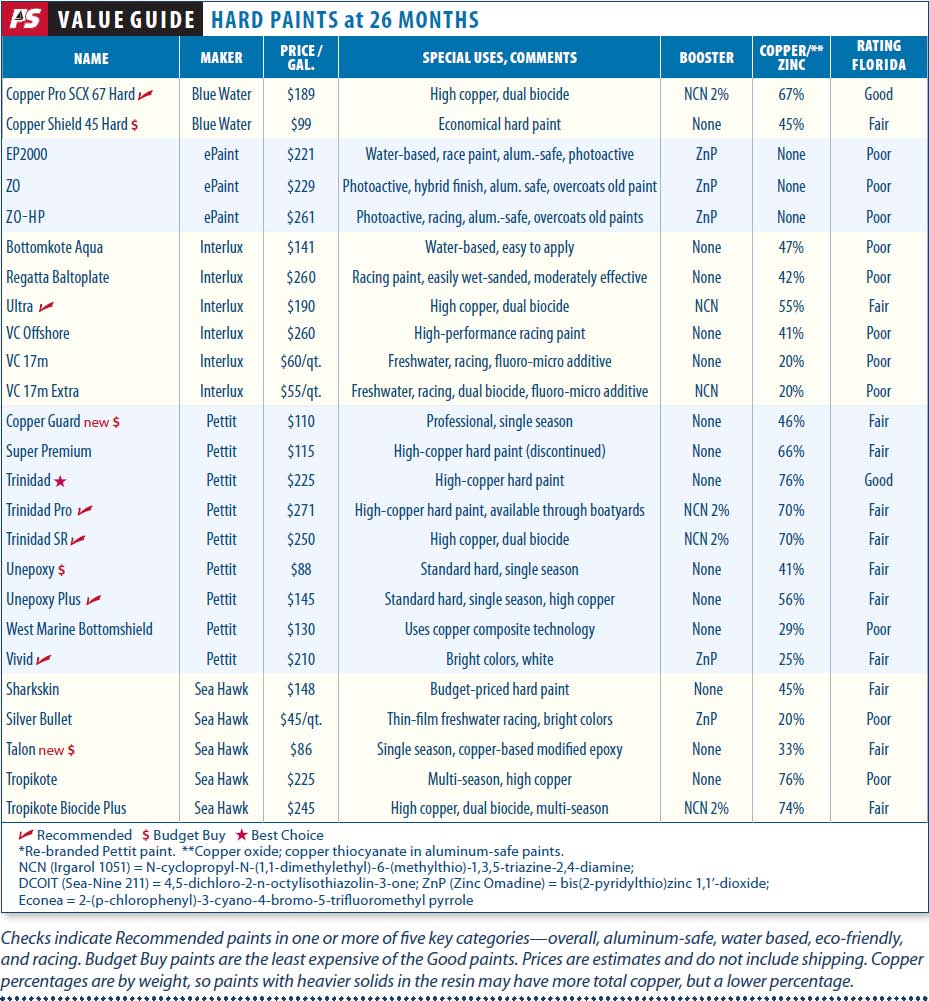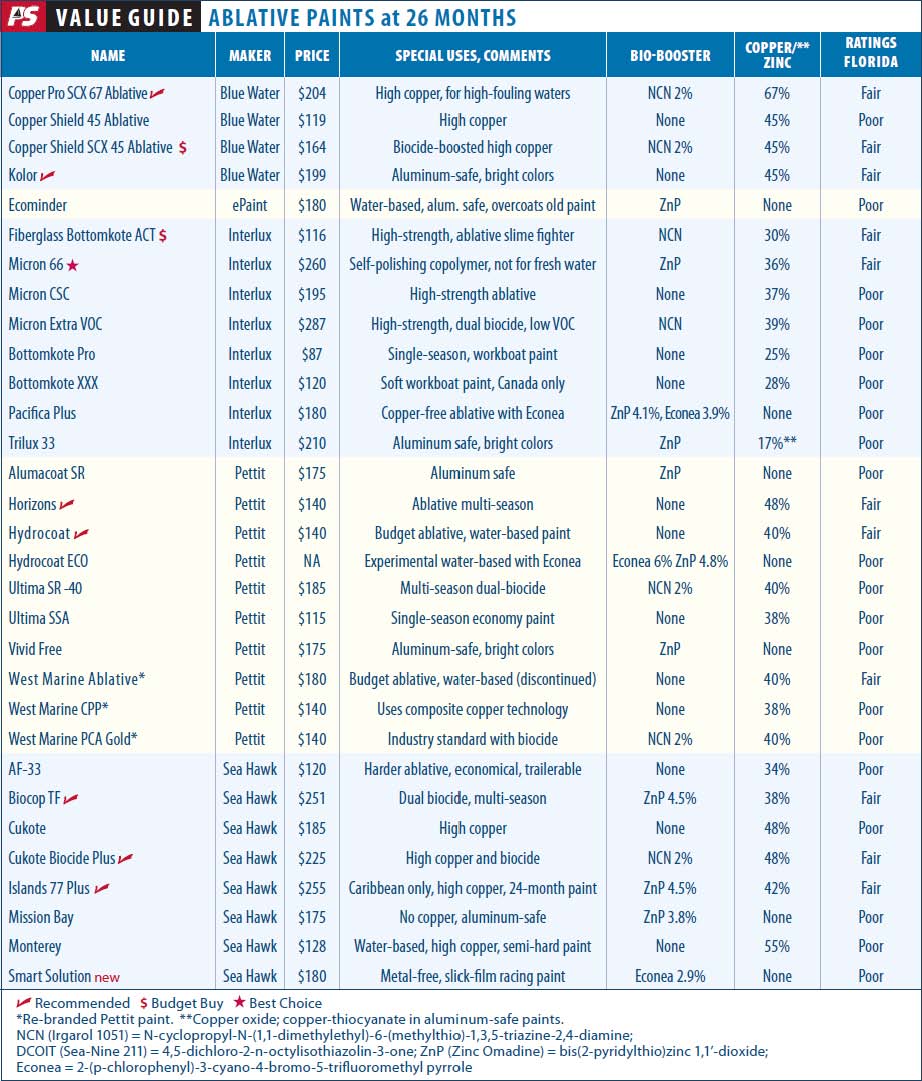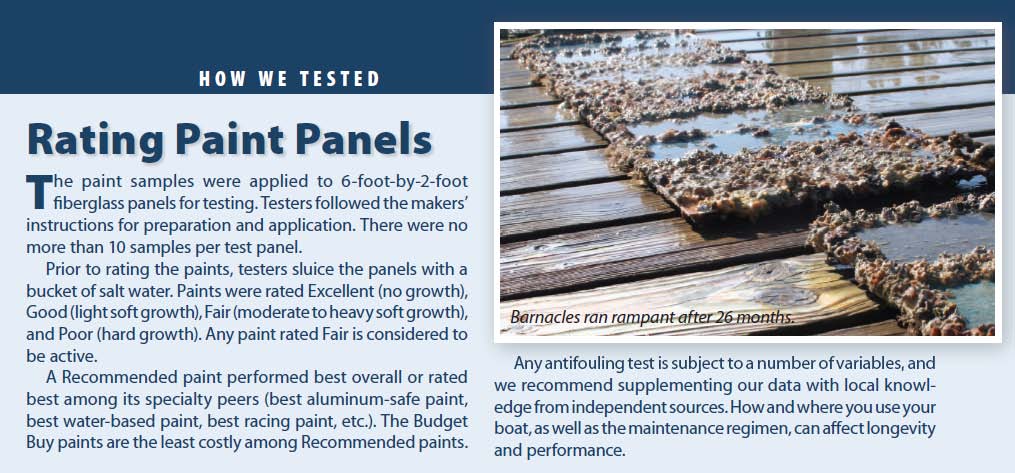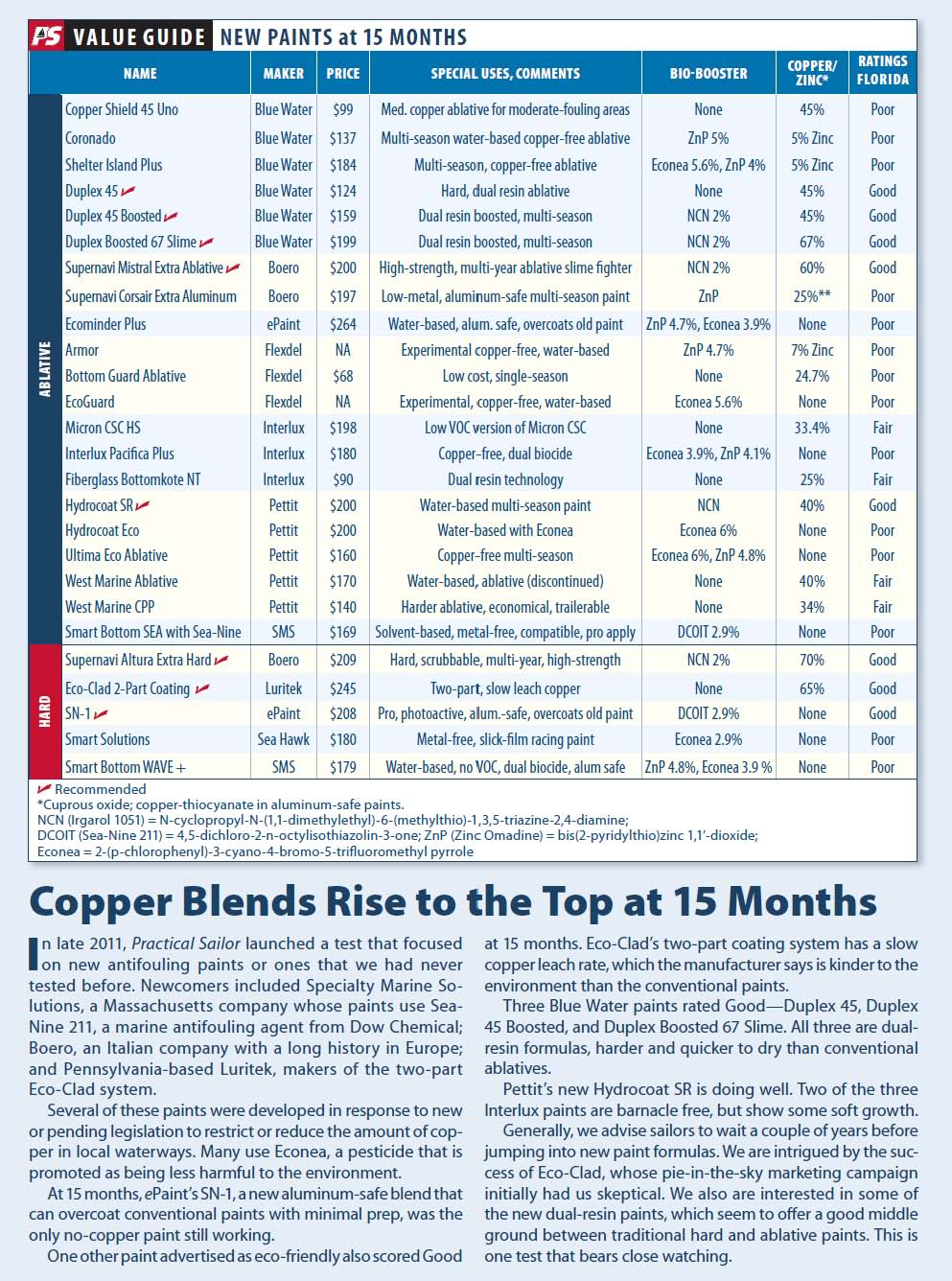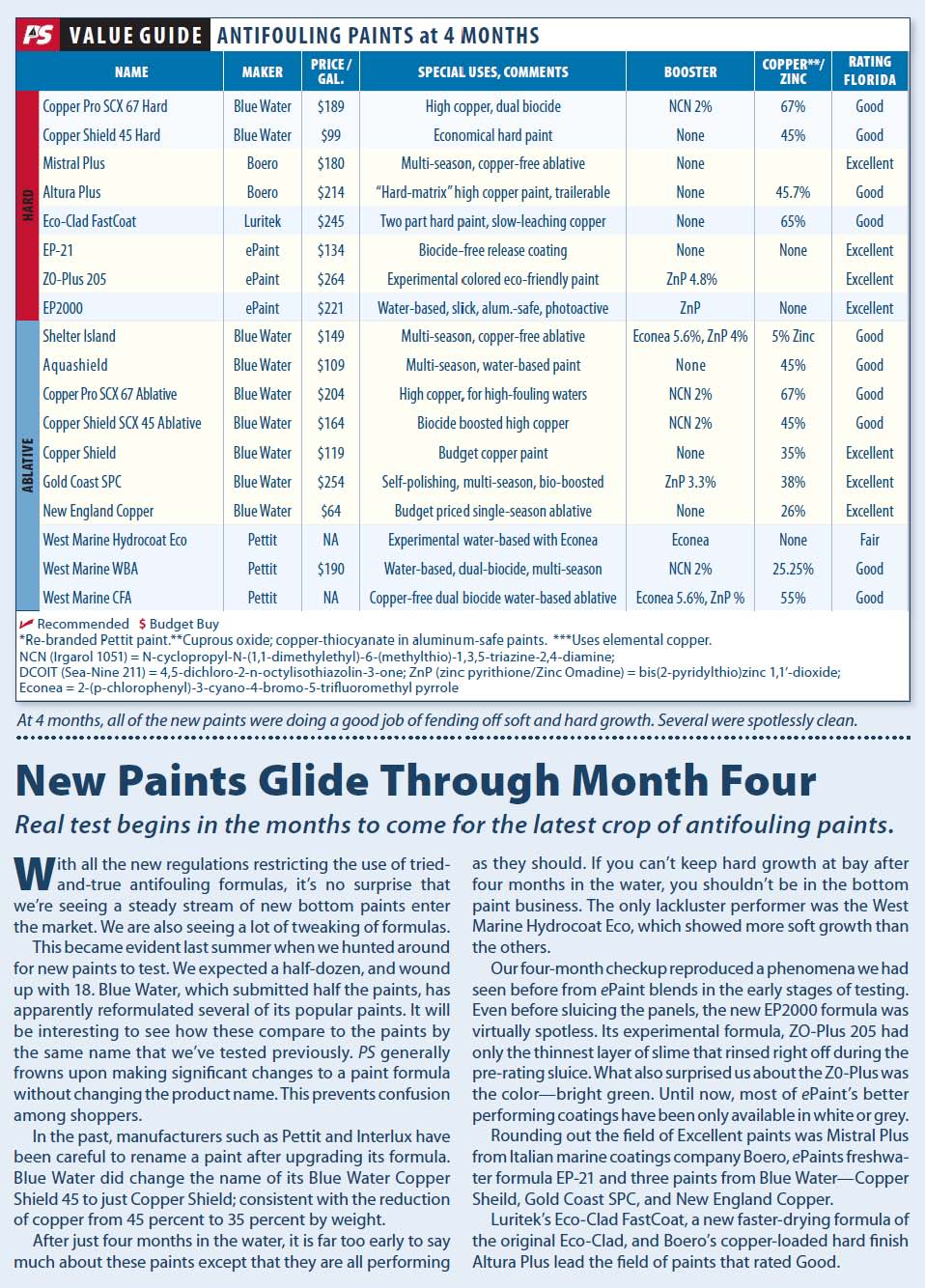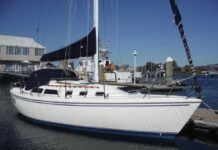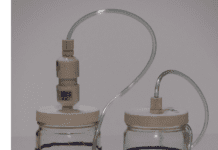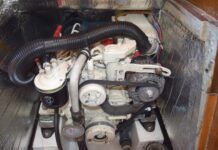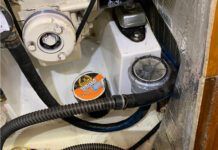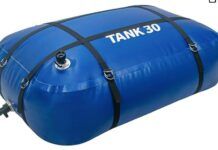After more than 30 years of testing bottom paint, you become a bit jaded when someone announces a revolutionary new formula. This time around, however, some interesting new paints have appeared on the radar, and are worth watching. Before we take a closer look at these paints and dig into the results of our most recent antifouling tests, a short recap is in order.
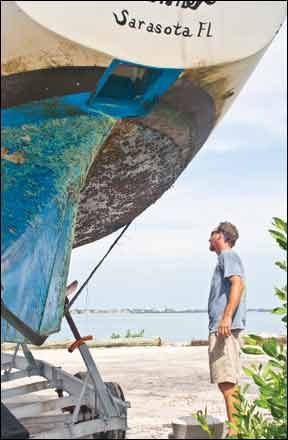
When we last checked on bottom paints in October 2012, three sets of panels were hanging perilously from a dock in the barnacle-infested waters of Sarasota Bay, Fla. A fourth set of panels that had been in the water for 36 consecutive months was rated and mercifully retired to the dumpster. In its final days, this set had 15 paints that were still valiantly combatting hard growth, but most of them were on their last legs.
We also reported on two other panel sets last October: one set that had been in the water 20 months, another nine months. Fifteen of the 60 or so paints on our 20-month panels had only light slime on them, earning a Good rating. Sea Hawk, Interlux, Blue Water, and Pettit all had top contenders; the best were generally the most expensive. Only two copper-free paints were still fighting barnacles.
On the nine-month panels, 14 paints scored Good or better. Most of the paints on the nine-month panel were new copper-free paints or low-VOC (volatile organic compound) paints introduced in response to environmental concerns over air quality and the effects of copper on marine life. Several of these paints were dual-resin blends, formulated with two types of resin to better control the release of biocide.
In this issue, we offer an update on these two panels-after 26 months and 15 months in the water-and take a peak at our newest panel set, which has only been in the water for four months.
What a difference six months makes. The 26-month panels have lost their zip. Were down from 15 Good paints to just three. The remaining survivors were rated Fair, meaning that they have only soft growth-no barnacles, mussels, or shells. Many of the survivors have thick coatings of slime and algae that suggest complete failure is imminent. In our view, stretching any of the Fair paints past the two-year mark in a fertile environment like Sarasota Bay will require regular cleaning.
The 15-month panel set is doing a little better. Were most interested in these panels because they highlight some second-generation eco-friendly paints, new water-based paints, and some new dual-resin blends-which are doing well. It also offers our first glimpse how the new widely marketed Eco-Clad system is working. A summary of findings from that panel set is on page 11.
The four-month panel hasn’t had enough time in the water to rate. Although it is still too early to evaluate these paints, there were four standouts that had virtually no slime. Details regarding this panel set are on page 12.
Two important things to keep in mind when choosing a paint: First, make sure your new paint is compatible with your existing paint, or be prepared for whatever extra prep work might be required. Usually, all that is required is some light sanding, and possibly, a primer coat, although in some cases, more aggressive sanding and surface prep is required.
Second, make sure the paint matches your needs. Most paints are formulated for specific situations. We loosely classify bottom paints into two categories: hard paints and ablative paints. Hard paints hold up well to underwater cleaning and can usually be burnished smooth for racing. However, they leave behind resins and pigments that build up over time and eventually will need to be sanded off. Also, many hard paints lose their punch when they are stored out of the water for long periods, while most ablatives can be hauled and re-launched without worries.
Ablative paints wear away, so they don’t build up paint layers over time. There are two main types-bottom-tier workboat ablatives that slough away to activate more biocide and more expensive copolymer ablatives that release biocides at a more controlled rate. Ablative paints are sometimes called soft paints, but this can be misleading. Some ablative paints, like the new dual-resin ablatives, are actually quite hard; designed to resist light underwater cleaning and are suitable for trailering.
The hard and ablative paints are further divided into five broad sub-categories that often overlap: freshwater paints, aluminum paints, racing paints, water-based paints (easy for the do-it-yourselfer to apply), and eco-friendly paints. Paint types are indicated in the accompanying tables, and we recommend the best paints in each category. For more on selecting paints, see Choosing a Bottom Paint for Dummies, www.practical-sailor.com/boat-maintenance/choosing-a-bottom-paint
.
WHAT WE TESTED
This article focuses on the 26-month panels and is supplemented by the tables on pages 8 and 9. The panels comprise 56 different antifouling paints that PS began testing in November 2010 at the Sarasota Sailing Squadron in Sarasota, Fla. All panels were inspected in January 2013. The participating companies include Blue Water Paints, Interlux, ePaint, Pettit, and Sea Hawk.
All paints were rated Good (relatively little soft growth), Fair (significant soft growth), or Poor (hard growth). There were no Excellent (spotless) paints after 26 months. See the accompanying How We Tested for details on the test procedures.
BLUE WATER
Based in North Brunswick, N.J., Blue Water Paints currently has four paints still repelling barnacles on our 26-month panels. Its copper-laden hard paint Copper Pro SCX 67 Hard, which is boosted with the slime-fighting pesticide Irgarol, was one of only two hard paints that scored Good. Copper Shield 45 Hard was one of the cleaner paints that were rated Fair. Among the ablatives, the budget-priced Copper Shield 45 Ablative, which had done well up to 20 months, joined the fallen, although the Irgarol-boosted blend Copper Shield SCX 45 Ablative was still kicking. Irgarol-boosted Copper Pro SCX 67 was the cleanest of the three Blue Water ablatives still standing. Kolor was the only aluminum-safe blend that was still keeping barnacles away, but it did have a relatively thick coating of soft growth. Blue Water Paints are also available under the MarPro label through its website, at boatyards, or through distributor Donovan Marine (www.donovanmarine.com).
ePAINT
ePaint specializes in copper-free paint, and several types have done well in past PS tests. They are often the cleanest panels in our tests during the first six to 12 months. ePaint 2000 succumbed to hard growth at 14 months, but the companys other two panels ePaint ZO and HP were still repelling barnacles at 20 months. At 26 months, the ZO and ZO-HP (a high-performance racing paint) had failed as well. All of ePaints blends are photoactive-releasing a layer of hydrogen peroxide around the hull when exposed to sunlight. Until recently, white and grey were the predominate colors; weve had the most success with white. (Our newest panel set, detailed on page 12, features the companys forays into new colors.) The companys lone ablative in our test, Ecominder, had failed earlier in testing. ZO, ZO HP, EP21, and SN-1 can safely be used over most hard antifouling paints. The other blends will require some additional prep work.
INTERLUX
As we saw in the 20-month checkup, Interluxs strongest performance came from its ablative paints, which have historically done well in our tests. All but one of the ablative paints, the budget-priced Bottomkote Pro, repelled hard growth at 14 months. By the 26-month mark, however, only two ablatives were still fighting barnacles. The cleanest were mid-priced Fiberglass Bottomkote ACT and top-of-the-line Micron 66, a paint that has consistently been one of the longest lasting ablatives in our tests. It is not recommend for freshwater use. Barnacles had just begun to take hold on the companys third cleanest panel, Bottomkote XXX, a soft, sloughing, budget-priced workboat paint that is sold in Canada. Interluxs Micron Extra VOC, a new low-VOC paint that was showing promise at the 20-month mark, has given up the ghost, but two years of protection matches past performance of the popular paint it replaces, Micron Extra.
In the hard paint category, the Irgarol-boosted Ultra was still resisting hard growth, but it was not as clean as some of the other paints in its category.
PETTIT/WEST MARINE
Pettit, a Kop-Coat brand, competes alongside Interlux for the largest share of the recreational antifouling marketplace. The company also manufactures West Marine brand paint, which accounts for a large percentage of its sales to the recreational market.
As in our 20-month report, Pettits hard paints gave a very strong showing at the 26-month mark. Except for the budget-priced West Marine Bottomshield, which rated Poor, all of Pettits hard paints showed no hard growth, scoring Fair or better. Even Pettits budget-priced hard paint, Unepoxy, was hanging in there, although it and the furrier Unepoxy Plus were clearly losing umph. Pettits copper-laden Trinidad, a perennial leader, was the cleanest of the hard paints, edging out that of Blue Water Copper Pro SCX 67 Hard.
In the ablative category, all but three of Pettits paints had reached the end of their life. The water-based Pettit Hydrocoat, available in an extremely wide range of colors, was barely hanging on. The other Pettit paints rated as Fair were West Marine Ablative (which is the same formula as Pettit Hydrocoat and has now been discontinued) and Pettit Horizons. Missing from the ablative lineup is Ultima SR60, a high-potency dual-biocide blend that will appear in future tests.
SEA HAWK
The tested samples from Florida-based Sea Hawk paints are holding fairly consistent with our expectations, with a couple surprises. In the hard-paint category, three of the five Sea Hawk paints we tested were still effective. Survivors included the budget-priced Sharkskin, the Irgarol-boosted Tropikote Biocide Plus, and the new Talon. Talon, like Pettits Unepoxy paint, is a modified epoxy formula promoted for single-season use, and, like Unepoxy, it is holding up after two years.
Among Sea Hawks ablatives, two zinc-boosted paints, Biocop TF and Islands 77 Plus (sold only in the Caribbean), proved to be the most formidable at 26 months. Cukote, the other copper-laden paint that was doing well at 20 months, bit the dust, as did the companys new eco-friendly paint Smart Solutions. The trailerable AF-33 had lost its potency as well, but it was one of the cleanest of the paints we rated Poor, suggesting it had only recently begun to fail.
CONCLUSION
Two years marks the beginning of the end for most antifouling paints under our test conditions. This doesn’t mean you wont see better performance on your boat. Our panels just sit at a dock that is known for its aggressive marine fouling, so if you use your boat frequently, or keep it in less fertile waters, you might get three years from the Good paints in our table. Keep in mind that our three top paints in this test would be overkill for a boat owner who paints his boat every year. For those sailors who haul out and paint every year, we recommend looking at the Budget Buy paints. Any of the Good paints from the 20-month checkup in the October 2012 issue would also serve well.
Because antifouling performance can vary with each location, we recommend consulting local experts, boatyards, and other boat owners to find out which of our recommended paints works best in your area. On a similar note, some paints have good years in our testing. So if long-term performance is your goal, you should cross-check the past one or two years of testing online at www.practical-sailor.com to see which paints consistently rise to the top.
Based on the performance of our 26-month panels, sailors looking for two years of protection against hard growth don’t need to pay a fortune, but they will want to think twice before banking on an eco-friendly paint. As in most previous tests, no eco-friendly paint survived past the two-year mark this time. For those shopping for the least expensive hard paint, Pettits new Copper Guard was the cleanest of the Budget Buys. Pettit Unepoxy, Sea Hawk Talon, and Blue Water Copper Shield 45 also earned Budget Buy ratings.
In the ablative category, Blue Waters Copper Shield 45 SCX and Interluxs Bottomkote ACT earned Budget Buy ratings. Pettits cheapest contender, Horizons, is only slightly more expensive. Frankly, all three had significant soft growth suggesting hard growth wasnt far behind.
Among aluminum-friendly paints, the only survivor was the ablative Blue Water Kolor, but it also was hanging by a thread-again reminding us that copper is still king over the long haul.
Pettits Vivid was the last man standing among paints marketed to the racing set. The hybrid hard-ablative has the added advantage of a varied color palette. Boaters looking for an easy-cleanup, water-based ablative will do well with Pettit Hydrocoat. Among the water-based hard paints, Interluxs Bottomkote Aqua just missed the cut at 26 months.
The overall winners? Only three paints, two hard and one ablative, rated Good after 26 months. These were the paints that clearly kept soft growth at bay better than the others. They were also among the most expensive in the group.
In the hard-paint category, Pettit Trinidad edged out Blue Water Copper Pro SCX 67. Both paints have done well in previous tests. Either would be a good choice for long-term cruisers planning to spend more than 18 months cruising before the next haulout.
In the ablative paints category, it was a close race between Interluxs Micron 66 and Blue Waters Copper Pro SCX 67 Ablative, with Micron 66 coming out on top. Sea Hawks Biocop TF and Islands 77 were close behind.
Cruisers looking for long-term protection should also look at the October 2012 three-year results available online at www.practical-sailor.com.
